Sorting colors is a big deal. Young learners in the toddler and preschool stage start out by sorting items such as blocks, plastic animals, coins, or colored items. Later in child development, sorting colors morphs into sorting silverware, matching socks, organizing drawers, or filing papers to name a few life skills.
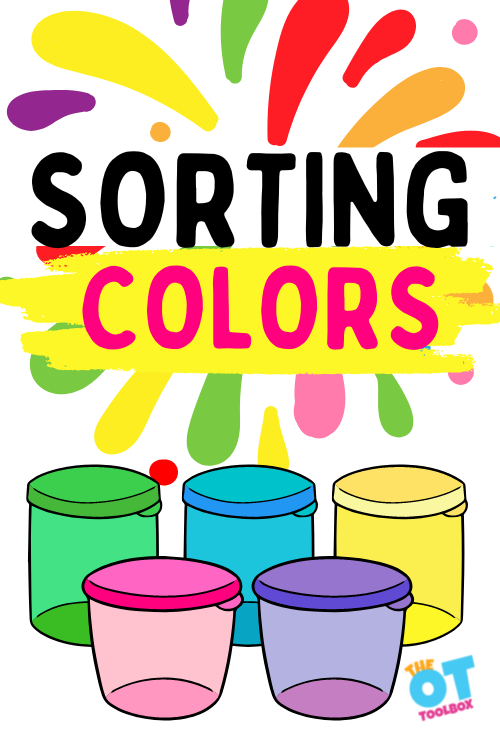
Sorting by color is an important skill for organizing items into categories to make sense of them, or for ease of locating them later. It is far easier to find a pair of socks in a drawer when they are matched together rather than in a large multi-colored pile. But what developmental skills are required for sorting colors? How can you support this essential skill?
Sorting Colors
First, let’s break down what we mean by sorting colors…
Sorting by color can refer to anything from colored blocks to silverware does not involve being able to name the item.
Developmentally, a young learner does not need to know their colors in order to sort. They are arranging the items according to their properties. You could sort foreign coins into their respective piles without any idea what they are. By participating in sorting color activities, the young child obtains hands-on practice in several areas of development:
- Visual discrimination
- Form constancy
- Working memory
- Color recognition
- Visual scanning
- Visual figure-ground
- Visual closure
- Visual attention
Hopefully as your learner continues to sort items, they may start recognizing the qualities of each item. This can include shade, or color, shape, form, number, etc.
Sorting Colors Development
As with many skills, there is a hierarchy of learning to sorting tasks. Young children develop these skills through hands-on play and by playing with toys.
Development of color sorting progresses through these stages:
- Grouping items that are exactly the same. Examples; colored plastic bears, blocks that are all the same size, coins, pompoms
- Sorting items that are similar: different brands of socks in similar colors, silverware in varying sizes, towels, a bag of buttons
- Sorting items that are similar AND different: sorting items by the color red, that are all different items. Sorting socks that are all different sizes, shapes, weights, and colors. Sorting items by colors that vary (five different shades of red).
- Sorting items that have more than one category This stage of development progresses to categorizing objects that can be sorted such as a pile of paper to file. In this case there needs to be one similar quality selected first in order to sort, such as putting all the medical bills together, sorting by date, alphabetizing the papers. The last stage is where we may see challenges impacted by working memory. Those struggling with development of executive functioning skills can be limited in sorting objects in various categories, particularly when a background is busy such as a messy desk, cluttered locker, or home.
Sorting by color is not the easiest way to sort. When there are multiple items that are similar such as 100 colored plastic balls, your learner may not recognize these as different items. They see balls first, not colors. Try sorting very different items first. Example: 5 identical buttons, 3 towels, 4 pencils, and 6 spoons.
Color Sorting and Visual Perception
Sorting involves recognizing an item’s properties, but also visual perception. Through development of these skills, children move from thinking through the sorting of colors to visual efficiency which allows for automaticity in tasks.
Below are some thought processes that integrate color sorting with visual perceptual skills:
- Figure ground lets the “perceiver” see the items as part to a whole,
- Form constancy recognizes that two balls of different colors are still balls. or two shades of red are still red.
- Visual discrimination allows the learner to tell difference between items.
- Visual memory is the ability to remember what is seen as the eyes are scanning the items
Color Sorting Teaches Mental Flexibility
When teaching sorting, teach mental flexibility. Sort many different items in many different ways. Sort by, color, size, similarity, quality (4 legged animals), texture, weight, or two qualities.
Sort the same items two different ways. First sort the plastic fruit and veggies (affiliate link) into color, then sort by type. Later your learner can sort by larger categories such as fruits versus vegetables.
Color Sorting and Functional Tasks
Why do some people have difficulty organizing and cleaning up?
Sometimes a large task seems very overwhelming, therefore shut down and refusal tends to occur. The most effective way to combat this is to teach sorting and categorizing. Go into your child’s messy room and look for the categories.
- Books all over the floor
- Dirty clothes everywhere
- Papers and trash scattered around
- 9 dishes and plates
- 29 stuffed animals
- 84 hair clips
- 64 crayons
Now this task seems much more manageable. I often had to solve this dilemma with my younger daughter.
What other, more complicated ways could she organize this messy room?
- Sorting the books into genre, size, type, or alphabetizing
- Organizing the dirty clothes into whites and colors
- Determining trash versus recyclables
- Crayons may be part of the “school supplies” category
- Hair accessories or toys might be a larger category
How would you tackle this chore?
- Sort into the larger category first such as books, then sort into their subcategories?
- Sort into subcategories such as stuffed animals, games, action figures, puzzles, then group into toys?
There is no wrong answer depending on how your brain works. Actually the only wrong answer is not getting started or having a meltdown.
When working on basic sorting colors, and feeling it is futile or pointless, think about the bigger picture. A person who can put their laundry, silverware, and toys away will be more independent than one who can not.
Color Sorting Activities
So, are you wondering about a fun way to build development in this area? We’ve got plenty of ideas.
The OT Toolbox has a great resource for teaching sorting using everyday items.
Amazon has tons of toys and games for sorting! (affiliate link) Don’t limit yourself to store bought items though. Your kitchen, bathroom, junk drawers, and desk are filled with items that can be grouped and sorted.
Color sorting activities can include ideas such as:
- Sorting colored circles (cut out circles from construction paper)
- Sort different objects by color and drop them into baskets or bowls
- Use color sorting activities along with a scavenger hunt. This color scavenger hunt is one fun idea.
- Cut out cardboard shapes and sort by color or shape. This cardboard tangram activity is an easy way to make shapes in different colors.
- Sort colored markers or crayons
- Laminate a piece of construction paper and use it as a play mat. Sort different colored craft pom poms or other objects onto the correct mat.
- Print out color words and sort them along with small objects. The Colors Handwriting Kit has these color words and other printable activities for playing with color.
- Make dyed pumpkin seeds and sort by color.
This color sorting activity is a powerful fine motor activity and a super easy way to learn and play for toddlers and preschoolers. We’ve done plenty of activities to work on fine motor skills in kids. This straw activity is the type that is a huge hit in our house…it’s cheap, easy, and fun! (a bonus for kids and mom!)
A handful of straws and a few recycled grated cheese container are all that are needed for tripod grasp, scissor skills, color naming, and sorting.
SO much learning is happening with color sorting!
Fine Motor Color Sorting Activity with Straws
This color sorting activity is a powerful fine motor activity and a super easy way to learn and play for toddlers and preschoolers. We’ve done plenty of activities to work on fine motor skills in kids. This straw activity is the type that is a huge hit in our house…it’s cheap, easy, and fun! (a bonus for kids and mom!) A handful of straws and a few recycled grated cheese container are all that are needed for tripod grasp, scissor skills, color naming, and sorting.
This color sorting activity is great for toddlers and preschools because it helps to develop many of the fine motor skills that they need for function.
I had Baby Girl (age 2 and a half) do this activity and she LOVED it. Now, many toddlers are exploring textures of small objects with their mouths. If you have a little one who puts things in their mouth during play, this may not be the activity for you. That’s ok. If it doesn’t work right now, put it away and pull it out in a few months.
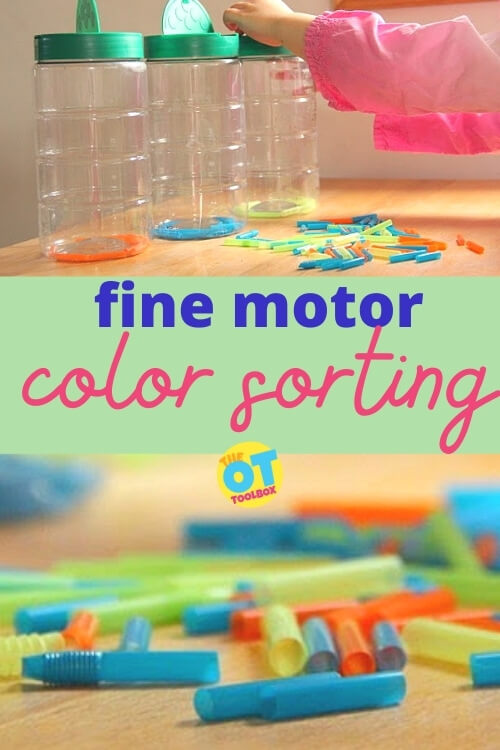
Always keep a close eye on your little ones during fine motor play and use your judgment with activities that work best for your child. Many school teachers read our blog and definitely, if there are rules about choking hazards in your classroom, don’t do this one with the 2 or 3 year olds.
You can adjust this color sorting activity to use other materials besides straws, too. Try using whole straws, pipe cleaners, colored craft sticks, or other objects that are safe for larger groups of Toddlers.
There are so many fun ways to play and learn with our Occupational Therapy Activities for Toddlers post.

color sorting activity using straws
We started out with a handful of colored straws. These are a dollar store purchase and we only used a few of the hundred or so in the pack…starting out cheap…this activity is going well so far!
Cutting the straws is a neat way to explore the “open-shut” motion of the scissors to cut the straw pieces. Baby Girl liked the effect of cutting straws. Flying straw bits= hilarious!
If you’re not up for chasing bits and pieces of straws around the room or would rather not dodge flying straw pieces as they are cut, do this in a bin or bag. Much easier on the eyes 😉
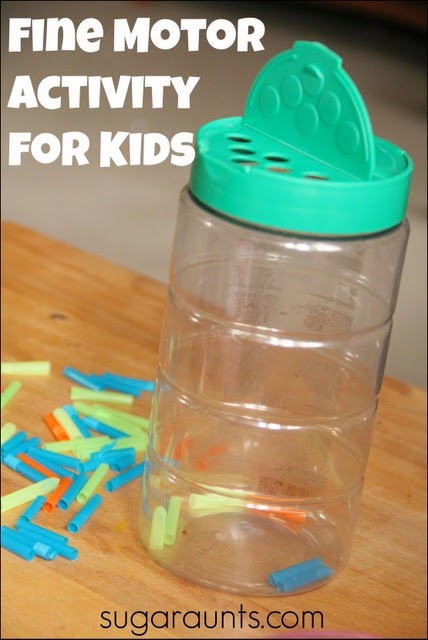
Once our straws were cut into little pieces and ready for playing, I pulled out a few recycled grated cheese containers. (Recycled container= free…activity going well still!) We started with just one container out on the table and Baby Girl dropped the straw pieces into the holes.
Here are more ways to use recycled materials in occupational therapy activities.
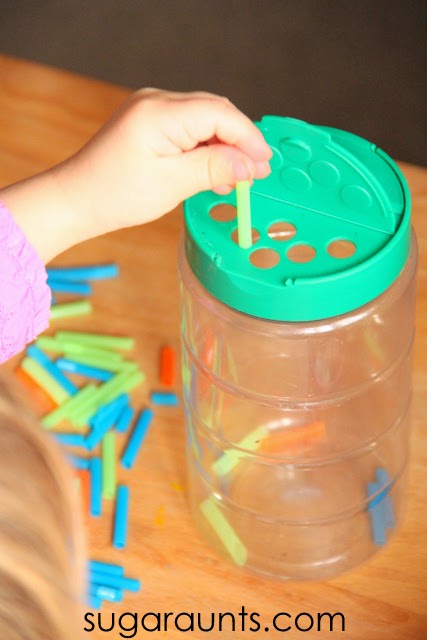
Importance of Color sorting for toddlers and preschoolers
Color sorting activities are a great way to help toddlers and preschoolers develop skills for reading, learning, and math.
Sorting activities develop visual perceptual skills as children use visual discrimination to notice differences between objects.
By repeating the task with multiple repetitions, kids develop skills in visual attention and visual memory. These visual processing skills are necessary for reading and math tasks.
The ability to recall differences in objects builds working memory too, ask kids remember where specific colors go or the place where they should sort them.
These sorting skills come into play in more advanced learning tasks as they classify objects, numbers, letters, etc.
And, when children sort items by color, they are building What a great fine motor task this was for little hands! Sorting straws into a container with small holes, like our activity, requires a tripod grasp to insert the straws into the small holes of the grated cheese container.

Sorting items like cut up straws helps preschoolers and toddlers develop skills such as:
- Fine motor skills (needed for pencil grasp, scissor use, turning pages, etc.)
- Hand strength (needed for endurance in coloring, cutting, etc.)
- Visual discrimination (needed to determine differences in letters, shapes, and numbers)
- Visual attention
- Visual discrimination
- Visual perceptual skills
- Left Right discrimination (needed for handwriting, fine motor tasks)
- Counting
- Patterning
- Classification skills
Preschoolers can get a lot of learning (colors, patterns, sorting, counting) from this activity too. Have them count as they put the pieces in, do a pattern with the colored straws, sort from smallest to biggest pieces and put them in the container in order…the possibilities are endless!

Color Sorting Activity with Straws
Once she got a little tired of the activity, I let it sit out on the table for a while with two more containers added. I started dropping in colored straw pieces into the containers and sorted them by color.

Baby Girl picked right up on that and got into the activity again. This lasted for a long time. We kept this out all day and she even wanted to invite her cousin over to play with us. So we did! This was a hit with the toddlers and Little Guy when he came home from preschool. Easy, cheap, and fun. I’ll take it!
Looking for more fun ways to work on color sorting?
- Rainbow Craft Pom Pom Color Sorting
- Colored Sticks Sorting
- Color Sorting Scissor Skills Activity
- Color Sorting with Colored Pumpkin Seeds
- Shape Sorting
- Bead Sorting Line Awareness Activity
You’ll find more activities to build hand strength, coordination, and dexterity in this resource on Fine Motor Skills.

Colleen Beck, OTR/L has been an occupational therapist since 2000, working in school-based, hand therapy, outpatient peds, EI, and SNF. Colleen created The OT Toolbox to inspire therapists, teachers, and parents with easy and fun tools to help children thrive. Read her story about going from an OT making $3/hour (after paying for kids’ childcare) to a full-time OT resource creator for millions of readers. Want to collaborate? Send an email to contact@theottoolbox.com.
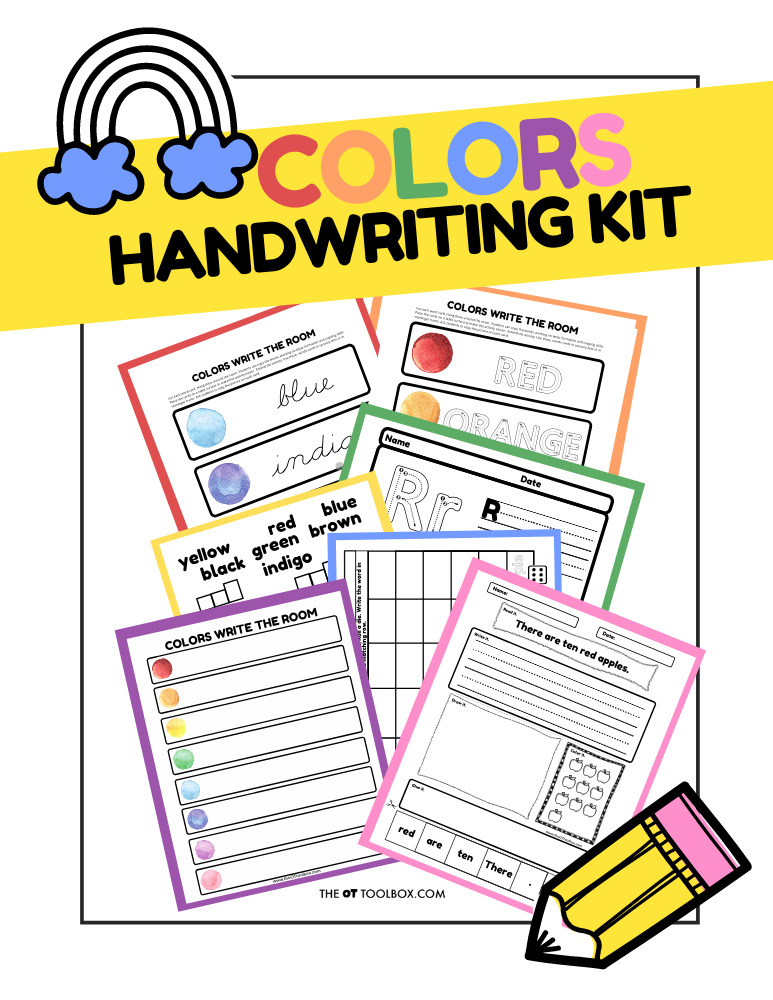
Rainbow Handwriting Kit– This resource pack includes handwriting sheets, write the room cards, color worksheets, visual motor activities, and so much more. The handwriting kit includes:
- Write the Room, Color Names: Lowercase Letters
- Write the Room, Color Names: Uppercase Letters
- Write the Room, Color Names: Cursive Writing
- Copy/Draw/Color/Cut Color Worksheets
- Colors Roll & Write Page
- Color Names Letter Size Puzzle Pages
- Flip and Fill A-Z Letter Pages
- Colors Pre-Writing Lines Pencil Control Mazes
- This handwriting kit now includes a bonus pack of pencil control worksheets, 1-10 fine motor clip cards, visual discrimination maze for directionality, handwriting sheets, and working memory/direction following sheet! Valued at $5, this bonus kit triples the goal areas you can work on in each therapy session or home program.






